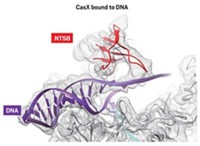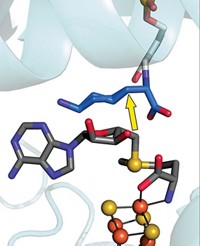Advertisement
Grab your lab coat. Let's get started
Welcome!
Welcome!
Create an account below to get 6 C&EN articles per month, receive newsletters and more - all free.
It seems this is your first time logging in online. Please enter the following information to continue.
As an ACS member you automatically get access to this site. All we need is few more details to create your reading experience.
Not you? Sign in with a different account.
Not you? Sign in with a different account.
ERROR 1
ERROR 1
ERROR 2
ERROR 2
ERROR 2
ERROR 2
ERROR 2
Password and Confirm password must match.
If you have an ACS member number, please enter it here so we can link this account to your membership. (optional)
ERROR 2
ACS values your privacy. By submitting your information, you are gaining access to C&EN and subscribing to our weekly newsletter. We use the information you provide to make your reading experience better, and we will never sell your data to third party members.
Biological Chemistry
Bacterial Protein Fixes DNA From A Distance
Bioinorganic Chemistry: Iron-binding protein Dps may use charge transfer to repair DNA damage in bacteria
by Erika Gebel Berg
October 22, 2013

Inside hosts, infectious bacteria have to endure an onslaught of oxidative stress unleashed by the host’s immune systems or antibiotics. But scientists don’t fully understand how the microbes fight back. Now, researchers report that a bacterial protein called Dps may protect the cells’ genomes by sending reparative electrons through the DNA chain to sites of oxidative damage (J. Am. Chem. Soc. 2013, DOI: 10.1021/ja408760w).
One of the most interesting features of Dps, according to Jacqueline K. Barton of California Institute of Technology, is that it’s mostly iron. The roughly spherical Dps has 24 iron-binding sites, which package iron atoms into the protein like an “M&M with a protein shell,” she says. But scientists don’t know what Dps does with all that iron.
Barton and other scientists think that Dps protects DNA from oxidative damage with the wealth of electrons in its iron-rich interior. They point to a couple of clues to support their hypothesis: The protein binds to DNA, and bacteria produce Dps under oxidative stress. Under these stressful conditions, reactive oxygen species such as hydrogen peroxide can attack DNA bases to produce radicals on the bases. Because of their unpaired electrons, the radicals eagerly react with water or other nearby molecules, damaging the bases. When a cell has damaged DNA bases in its genome, it struggles to properly transcribe genes or replicate its DNA. A protein like Dps, with its 24-iron center, could transfer electrons to the radicals formed under oxidative stress to neutralize their reactivity and prevent damaged bases from forming.
The problem is that bacteria don’t produce enough Dps to cover much of an average bacterial genome. As a result, there could be long stretches of DNA without a Dps close enough to move in and neutralize a radical before it reacts with other molecules.
Barton thought of how Dps could get around that problem. Charges can move long distances through the stacked DNA bases in the double helix, she says. So she hypothesized that Dps may protect the genome via charge transfer, sending electrons through DNA’s stacked bases to fix oxidative damage at distant sites.
To test the charge-transfer hypothesis, Barton, along with graduate student Anna R. Arnold, studied Dps and damaged DNA in test tubes. The duo first developed a way to cause DNA damage. They chose a ruthenium moiety to do their dirty work. The researchers inserted the ruthenium species into a 70-base-pair strand of DNA and hit the molecule with light. The light triggers a chain reaction that primes the ruthenium species to steal an electron from a DNA base to generate a radical. Oxidized DNA strands differ in size from untouched DNA, so the researchers could use gel electrophoresis to separate the DNA strands and see the damage inflicted. The chemists repeated the experiment, but this time added Dps to the mixture, and found an 80% reduction in DNA damage.
The Dps is likely acting at a distance, Barton says. In another experiment, the chemists used fluorescence spectroscopy to monitor light emitted by the ruthenium-DNA complex. When they added Dps, they saw no change in the luminescence compared to the ruthenium-DNA complex alone, suggesting that the protein doesn’t come in close contact with the ruthenium molecule.
Cynthia J. Burrows of the University of Utah says the findings offer a possible new therapeutic strategy for bacterial infections. Developing antibiotics that shut down Dps “could be a way to go after pathogenic bacteria.”
Barton agrees. “Dps is protecting the bacteria,” she says. “If we can turn off that protection mechanism, it’s a new antibiotic target.” Her future plans are to continue studying how organisms use charge transfer to send signals through DNA.





Join the conversation
Contact the reporter
Submit a Letter to the Editor for publication
Engage with us on Twitter